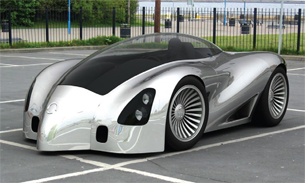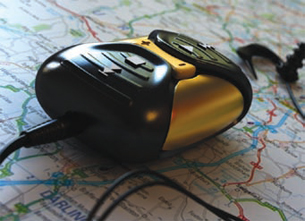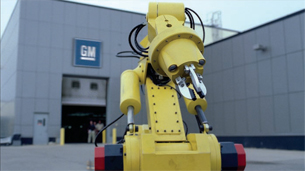Latest News
December 1, 2008
By Mark Clarkson
 Photoreal rendering of a concept automobile, integrated into a photographed environment. |
Let me start with a caveat: I’m a long-time LightWave 3D user. Luxology, modo’s manufacturer, was founded by key LightWave developers and the lineage shows — the 3D modeler has a very LightWave-y feel to the way it goes about things. Consequently, modo feels very comfy to me, more so than it might for users unfamiliar with LightWave.
Sculpt & Paint
Sculpting is the “next big thing” in organic modeling (witness Autodesk’s acquisition of Mudbox) and modo does 3D sculpting and painting really well.
Do you want to design, say, an MP3 player? Subdivide a cube and scale it to pleasing dimensions. Next, sculpt the mesh in real time by clicking and dragging with different tools. “Raise” up some buttons. “Carve” out seams and a screen, “Smooth” out the corners. You can either sculpt the geometry itself, or use an image-based displacement map. Both methods feel the same from a sculpting standpoint, and each has its advantages.
Finally, use a paint brush tool and throw some color on there. Once again, you brush or spray or fill directly on the onscreen geometry.
The results might look pretty rough — mine certainly did — but you’ve only invested a couple of minutes. Spend a dozen more. Play around with the shape. It’s cheap and easy (and even kind of fun).
This is the right-brain part of the process.
When you’ve got a design you like, it’s time to move on to the actual modeling.
 modo rendering of a prototype MP3 playershowing surface details that are possible. |
Polygon & Subdivision Modeling
To create a final model of your MP3 player, you have to spend a little more time thinking; this is the fiddly, left-brain part of the process.
Modeling in modo consists, at its core, of manipulating polygons and their edges and vertices. All 3D objects are polygon meshes. modo provides smooth, organic surfaces via subdivision surfaces (SDS) created from polygon meshes. You can toggle between SDS and polygon mode by pressing the Tab key, which I found to be an amazingly comfortable way to work.
Your quick-and-dirty sculpted version isn’t wasted. modo allows you to place a mesh in the background and snap new polygons to it, in 3D space, so you can lay down geometry that follows the curves and lines of the sculpted version.
You can use the sculpt tools here, too, even on a low-density mesh. I found the Smooth and Inflate tools especially useful.
Falloffs
Key to working with modo’s idiosyncratic modeler is the Falloff tool. Simple example: subdivide a simple box. Now drag a linear falloff down one axis and rotate the box. The vertices at one end of the falloff move; the vertices at the other end don’t. The vertices in between follow the curve of the falloff you’ve defined; the effect of the rotation ‘falls off.’
The falloff remains live, so you drag it around and change the curve shape and observe how it affects the rotation of your box.
There are a dozen different kinds of falloff, including radial and cylindrical, selection-based, path-based, and noisy. You can stack falloffs together, combining, say, radial and linear falloffs for more elaborate effects.
Instead of using the standard Bend tool, you might construct your own custom tool on the fly using the Rotate tool in conjunction with a falloff. This may seem awkward at first, but it allows you to combine tools in interesting and novel ways.
Many of modo’s stock tools turn out to be such combinations; the Twist tool, for example, is an axis rotation with a linear falloff. You can create your own presets (e.g., Mark’s Radial Bend Tool), and add them to your tool palettes, tabs, and pop-up menus.
 Los Angeles-based SWAY Studio created an endearing little robot using modo and then broughtit to life in a General Motors TV advertisement. |
Texturing & Animation
modo’s texture editor is set up similarly to Photoshop’s, with stacks of layers, each affecting those beneath it. You can build up very elaborate materials.
For more intricate textures, modo has a full set of UV mapping tools. modo’s UV map appears to be just another representation of your mesh. This means that you can paint directly on the UV map; you can resize, reposition, and even sculpt the map; and when you edit mesh geometry, the UV map doesn’t break.
modo’s sophisticated texturing, combined with its physics-based lighting, global illumination, HDRI lighting, and natural daylight, make photorealistic renders relatively easy to produce.
modo’s animation is basic, but well implemented and more than adequate for most product design work. You can animate all the basic transforms — rotation, position, etc. — as well as opacity, color, and the like. You can animate the time and position of modo’s physical sun.
And you can use morphs to animate between different versions of the same mesh.
Help me, please
Help is lurking everywhere in modo, maybe even in too many places. There’s the Quick Tips tab, the Explore modo link in the File menu, tutorials, and other documentation under the Help menu, and even more stuff on Luxology’ssite.
Best are the video tutorials, and there are plenty of them. You’ll discover all kinds of cool tricks, but there’s no telling just where you’ll discover them. That great insight into action centers could be hiding absolutely anywhere. A few are flat wrong, directing you to click on a tab that’s no longer there.
The problem extends into the User Guide and Reference Guide which, for example, painstakingly detail every setting in the Global Illumination panel, but never hints at where you might find the blasted thing.
Limitation & Strength
Compared to, say, Maya or 3ds Max, modo seems quite limited. There are no solids, no parametric objects. You cannot go back to a cylinder created last week and change its number of sides. There is no particle system, no dynamics, no rigging tools for sophisticated animation.
But, if you look at modo as a design prototyping tool, then it’s marvelously complete. There is sculpting and painting, modeling and rendering, real-world physical lighting, and basic animation — enough to create the simple turntable views or animations of cell phones flipping open.
Sometimes, the overwhelming completeness of the big boys (e.g., 3ds Max) is a barrier to quickly “sketching” new designs or rendering simple scenes. It doesn’t hurt that, at $895, modo costs a fraction as much.
My experience with modo wasn’t all roses; I had some crashes and recurring issues with texture previews. But, overall, I’m impressed. Pull down the free trial and form your own impression.
More Info:
Luxology, LLC
San Mateo, CA
Downloadable version - $895
Trial version
Contributing Editor Mark Clarkson has been writing about all manner of computer stuff for years. An expert in computer animation and graphics, his newest book is “Photoshop Elements by Example.” Visit him on the web at markclarkson.com or send e-mail about this article c/o [email protected].
Subscribe to our FREE magazine, FREE email newsletters or both!
Latest News
About the Author
Mark ClarksonContributing Editor Mark Clarkson is Digital Engineering’s expert in visualization, computer animation, and graphics. His newest book is Photoshop Elements by Example. Visit him on the web at MarkClarkson.com or send e-mail about this article to [email protected].
Follow DE





